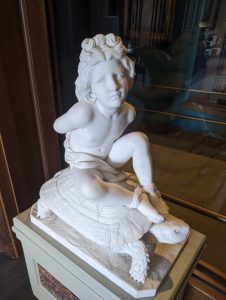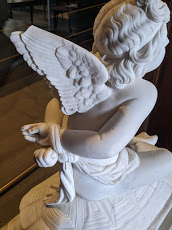By Angela Tillapaugh

This sculpture, located in the Reading Room of the MHS, shows Cupid sitting on the back of a moving tortoise. His wrists and ankles are bound by a single bolt of fabric and he looks off into the distance. The artist behind this sculpture is the 19th century sculptor Richard Saltonstall Greenough, who was born in Boston and moved to Italy as a young adult to pursue a career in sculpting. Italy was a popular choice for expatriate sculptors due to the abundance of marble quarries and numerous skilled craftsmen.[i] It was challenging to study sculpting in the United States as most sculptures were utilitarian, such as tombstones and weathervanes. American artists, like Richard Greenough and his older brother, Horatio, were among the early artists who introduced Neoclassical sculpture to the States. Neoclassical art was born in Rome after the discovery of ancient sites like Pompeii in the early 19th century. After these archeological findings, there was a resurgence of interest in classical antiquity and many artists began creating works that emulated the art from ancient Rome and Greece.
This sculpture of Cupid is undoubtedly a Neoclassical work of art, which often used Greek and Roman mythology as subject matter. Greenough usually sculpted portraits. In Cupid and the Tortoise, Cupid is a portrait of Amy Shaw Warren. The portrait is based on sketches Greenough made of Warren when she was three years old. Neoclassical art often mixed portraiture with mythology, presenting someone in the guise of a mythological figure could help convey a story or ideas about them to a viewer. Cupid is an appropriate choice to use for a portrait of a child, as he is usually depicted as a baby or a young boy.

Cupid is often used in art to suggest the state of love between other figures in the work. A bound Cupid could represent someone’s dominance over love, or a languishing romance between two people. But here, Cupid is alone except for the tortoise. Perhaps Cupid was punished for getting into mischief which is another common story in mythology. Someone could have tied up Cupid as a punishment and then placed him on the back of a tortoise to be sent home to his mother, Venus. Regardless, Greenough provides the viewer with no visual cues that could explain why Cupid is bound by the wrists and ankles and sitting on a tortoise. Instead, Greenough places the focus on individual elements of the sculpture such as the portrait of Amy Shaw Warren and the beautifully detailed tortoise. It is the choice of the viewer to fill in their own interpretations of why exactly Cupid is being carried away by a tortoise.
[i] Tolles, T. (2004, October). American Neoclassical Sculptors. Retrieved July 08, 2020, from https://www.metmuseum.org/toah/hd/ambl/hd_ambl.htm

